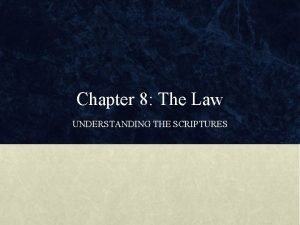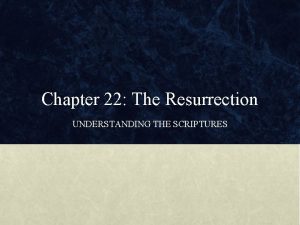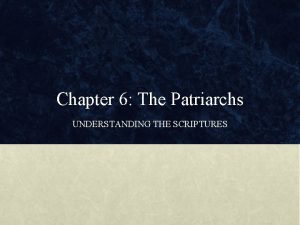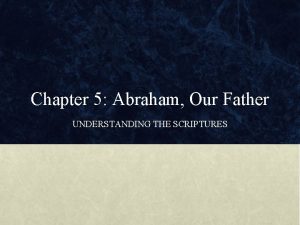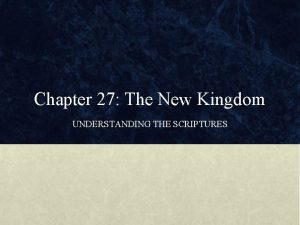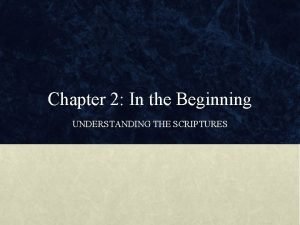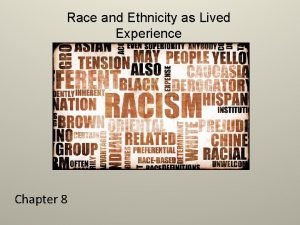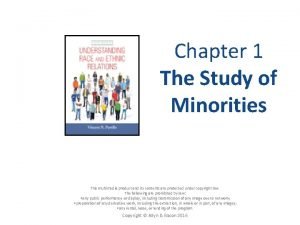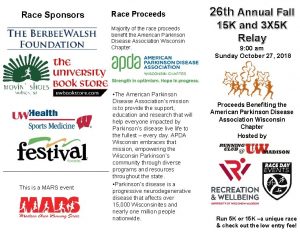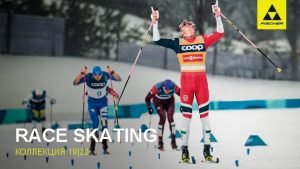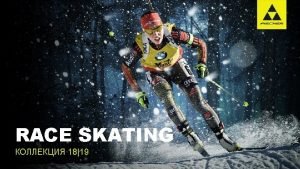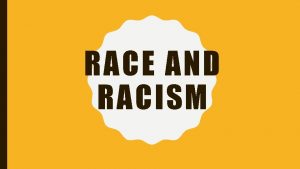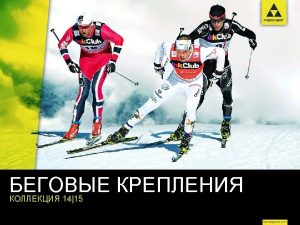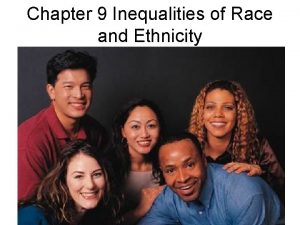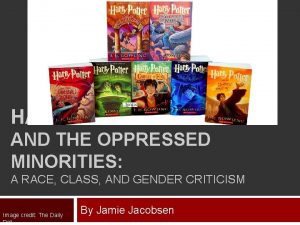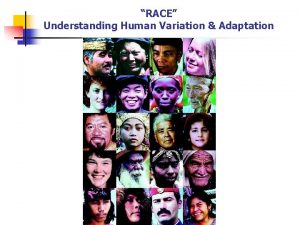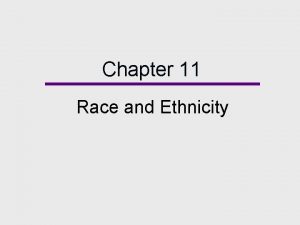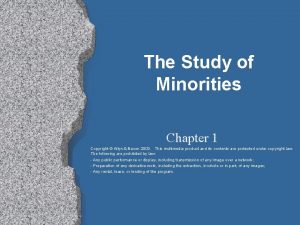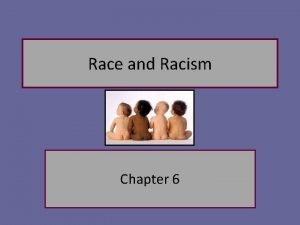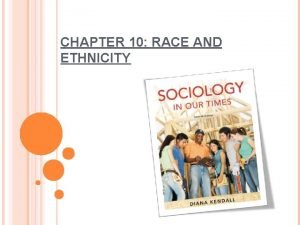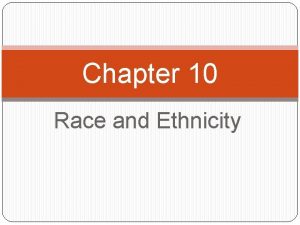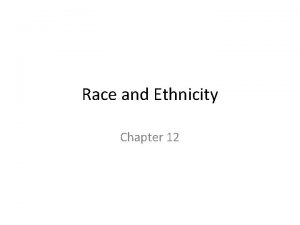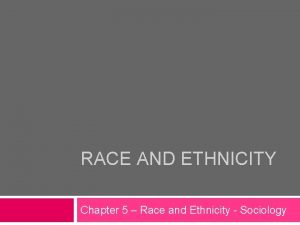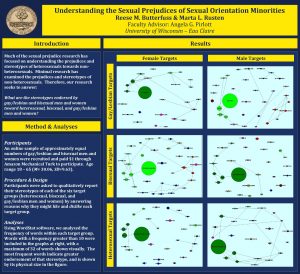Chapter 1 The Study of Minorities Understanding Race





































- Slides: 37

Chapter 1 The Study of Minorities Understanding Race and Ethnic Relations 3 rd Edition This multimedia product and its contents are protected under copyright law. The following are prohibited by law: • any public performance or display, including transmission of any image over a network; • preparation of any derivative work, including the extraction, in whole or in part, of any images; • any rental, lease, or lending of the program. Copyright © Allyn & Bacon 2016

Chapter 1 Learning Objectives • To introduce students to the sociological perspective for the study of race and ethnic relations. • To present the concept of the social phenomenon of the stranger as the focus through which to understand majority-minority interaction. • To acquaint students with the concepts of minority (subordinate) groups, ethnocentrism, social distance, the three major sociological perspectives, and the problem of objectivity.

Chapter 1 Learning Objectives (cont) • To familiarize students with the concept of the Dillingham Flaw and its relevance to the acceptance of diversity.

Similarity and Attraction • Aristotle (384 -322 BCE) – “We like those who resemble us, and are engaged in the same pursuits. ” – Cross-cultural studies find that individual’s like others because of similar attitudes, values, beliefs, social status, or physical appearance. – “Birds of a feather flock together” part of U. S. cultural folklore.

The Stranger as a Social Phenomenon • Social distance – Five national studies were completed by Emory Bogardus. – Relatively consistent positioning of response patterns illustrated the similarity-attraction relationship. – Distribution over 50 -year period showed White Americans, Canadians, and northern and western Europeans in top third; southern, eastern, and central Europeans in middle third; racial minorities were located near the bottom third.

The Stranger as a Social Phenomenon (cont) While ethnic Whites remained in the top position, African Americans leaped from the bottom third to the middle during this period. Moreover, Italian Americans managed to become the first group not from northwest Europe to make it to the top third (see Table 1. 1, page 5).

Perceptions • Perceptions – Simmel theorized that strangers represent both nearness and remoteness. Nearness because they are physically close; and remoteness because they have different values and ways of doing things. – Categoric Knowing: The classification of others on the basis of limited information usually obtained visually or verbally.

Perceptions (cont) Categoric knowing serves as the basis behind many stereotypes. – Natives perceive stranger in abstract, typified way. The individual stranger thus becomes totality or stereotype of group as a whole.

Interactions – Migration: Movement of people in and out of specified area. – Emigration: Narrower term referring to movement of people out of a country to settle into another. – Immigration: Movement of people into another country to take up residency.

Interactions (cont). – Can speak of emigration of people out of a county and their immigration into another.

THEORETICAL PERSPECTIVES IN STUDY OF RACE/ETHNIC RELATIONS Emphasis View of Society Interaction Processes Interaction Results Reason for Problems How to Improve Society Functionalist Macrosocial View Conflict Theory Macrosocial View Focus on cooperative social Focus on society as continually system of interrelated parts that is engaged in a series of relatively stable disagreements, tensions, and clashes Interactionist Microsocial View Focus on microsocial world of personal interaction patterns in everyday life Societal elements function together to maintain order, stability, and equilibrium Conflict is inevitable because Shared symbols and definitions there is always a societal elite and provide the basis for interpreting an oppressed group life experiences Societal dysfunctions result from temporary disorganization or maladjustment Disequilibrium and change are the norm because of societal inequalities An internalized social construction of reality makes it seem to be objective reality Rapid social change is the most frequent cause of societal equilibrium False consciousness allows the ruling elite to maintain power and benefit from exploitation Shared expectations and understandings, or their absence, explain intergroup relations Necessary adjustments will restore the social system to equilibrium Group struggle against oppression Better intercultural awareness will is necessary to effect social improve interaction patterns change Source: Parillo, Table 1. 2, Understanding Race and Ethnic Relations (2016), 28.

Social Construction of Reality • Social Construction of Reality—Individuals create background against which to understand separate actions and interactions with others. • Individuals thus create cultural products, loosing awareness overtime of having created their own social and cultural environment (objectification). Internalize these supposed facts of objective reality through socialization process (internalization).

Minority (Subordinate) Groups • The term minority group – Group connotes a small, closely interacting set of persons. – Minority group does not refer to a group’s numerical representation. – Refers to a group’s relative power and status in society. For this reason, “subordinate” group oftentimes seen as more accurate term

Minority/Subordinate Group Characteristics • Three historic classifications – Donald Young: Americans use in context of race or and national origin. – Louis Wirth: Expanded definition to include group consciousness and differential treatment. Enlarged focus of groups studied. – Third examines power relations within existing social hierarchy.

Minority/Subordinate-Group Characteristics Group members practice endogamy Membership is an ascribed status Feels a sense of peoplehood Identifiable by distinguishing physical or cultural traits that are held in low esteem Receives unequal treatment as a group

Racial and Ethnic Groups • Dominant Group – Group that has social, political, and economic dominance. Not necessarily numerically superior. Minority group occupies subordinate status relative to dominant.

Racial and Ethnic Groups (cont) • Race – A categorization in which a large number of people sharing visible physical characteristics regard themselves or are regarded by others as a single group on that basis. • Ethnic group (ethnicity) – A group of people who share a common religion, nationality, culture, and/or language.

Social Construction of Race: The Brazilian Experience Brazil’s racial formation differs from that found in the US. The Brazilian categorize race differently than we do in the U. S.

Social Construction of Race: Brazil

Social Construction of Race: Brazil

Racial and Ethnic Groups (cont) • Racism – An ideological belief system that links the biological conditions of a human organism with alleged sociocultural capabilities and behavior asserted to prove superiority of one group over another.

Joseph Arthur Comte de Gobineau (July 14, 1816 – October 13, 1882) was a French aristocrat who developed theory of the Aryan master race in his book An Essay on the Inequality of the Human Races (1853 -1855). Gobineau was a successful diplomat whose career in Iran influenced the development of his ideas. He came to believe that race created culture. In his view the development of empires created racial mixture, which led to the 'degeneration' of races. He called this process Semiticization, because of his belief that Semitic peoples were a product of the Middle. Eastern cross-over between the otherwise distinct "black", "white" and "yellow" races. Gobineau was known for his reactionary aristocratic politics, as well as his hatred of mass democratic culture. He believed himself to be the descendant of Nordic Vikings and Condottieri. The Count Joseph Authur de Gobineau was a supporter of eugenics. He heavily influenced 19 th century thinking concerning race. He referred to race as a cluster of inherited characteristics. De Gobineau argued that there are three races: the White, Black, and Yellow. According to De Gobineau, Whites were the most evolved of the three races and Blacks the least evolved. De Gobineau equated cultural evolution with biological.

Ethnocentrism • Ethnocentrism – A view of things in which one’s own group is the center of everything, and all others are scaled and rated with reference to it.

Ethnocentrism (cont) Ingroup ◦ Group to which an individual belongs to and which they feel loyalty towards. Outgroup ◦ Consists of groups individuals are not member of. Reference group ◦ Outgroup viewed as exemplary model by ingroup due to its perceived advantages.

Ethnocentrism (cont) • Social identity theory: – Ingroup members automatically think of their group as being better than outgroups. Enhances social status and social identity and raises value of self-image.


Other Subordinate Groups LECTURE SUPPLEMENT: Sex, Gender, and Sexual Orientation Slides 24 -29

Sex and Gender The Biological Perspective Assumes that innate biological differences between men and women shape the contributions that each can make to society.

Sex and Gender Sex The biological terms for male and female. n Gender The learned behavior involving how we are expected to act as males and females in society. n Masculinity and femininity are learned n

Sex and Gender Sexism The belief that one sex is innately superior to the other. Serves as justification for patriarchy.

Human Sexuality: The capacity to have erotic experiences and responses. Sexual orientation: Describes an enduring pattern of attraction—emotional, romantic, sexual, or some combination of these—to the opposite sex, the same sex, both, or neither, and the genders that accompany them. By the convention of organized researchers (i. e. the social construction of reality), the attractions associated with sexual orientations are subsumed under heterosexuality, homosexuality, bisexuality, and asexuality.

Human Sexuality Transgender: Is a general term applied to a variety of individuals, behaviors, and groups involving tendencies to vary from culturally conventional gender roles. "Transgender" does not necessarily imply any specific form of sexual orientation. Androgyny: Is a person who does not fit cleanly into the typical masculine and feminine gender roles of their society. They may also use the term ambigender to describe themselves.

The Dillingham Flaw • The Dillingham Flaw – A committee conducted between 19071911 by Senator William P. Dillingham. – Using an inaccurate comparison based on simplistic categorizations and antiquated judgments. – Seriously undermines the scientific worth of supposedly objective evaluations.

William P. Dillingham Dec. 12, to July 12, 1923 A Republican lawyer, from 1900 till his death in 1923, Dillingham occupied the seat of senator for the state of Vermont. He chaired the Senate commission that from 1907 -1911 produced a 48 -volume report on immigration. Dillingham concluded that immigration from southern and Eastern Europe posed a threat to the national security of the U. S. as a result of its transforming the U. S. from a literate, Protestant society based on private property to a rural, non-Protestant nation full of disease, illiteracy, and crime. The commission Dillingham headed recommended that immigration from southern and eastern Europe be greatly reduced.

Scientific Method • The Scientific Method Involves repeated objective observations, precise measurement, the formulation of theories based on the best possible explanations, and the gathering of additional information following of the questions following from those theories.

Personal Troubles and Public Issues • C. Wright Mills explained that an intricate relationship exists between individual lives and the larger historical context – Public issues are matters concerning the public that transcend the local environments of the individual. – Personal troubles are matters concerning individual relations with others.

Ethnoviolence and Nativists • Ethnoviolence – Hostile behavior against others solely because of their race, ethnicity, religion, or sexual orientation. • Nativists – Individuals who advocate a policy of protecting interests of native inhabitants against those of immigrants.
 Data race vs race condition
Data race vs race condition Mechanical efficiency of turbine
Mechanical efficiency of turbine Head race and tail race
Head race and tail race Understanding the scriptures chapter 24 study questions
Understanding the scriptures chapter 24 study questions Understanding the scriptures chapter 22 study questions
Understanding the scriptures chapter 22 study questions Understanding the scriptures chapter 20 study questions
Understanding the scriptures chapter 20 study questions Understanding the scriptures chapter 6 study questions
Understanding the scriptures chapter 6 study questions Understanding the scriptures chapter 5 study questions
Understanding the scriptures chapter 5 study questions Understanding the scriptures chapter 2 study questions
Understanding the scriptures chapter 2 study questions Understanding the scriptures chapter 2 study questions
Understanding the scriptures chapter 2 study questions Chapter 8: race and ethnicity as lived experience
Chapter 8: race and ethnicity as lived experience Hình ảnh bộ gõ cơ thể búng tay
Hình ảnh bộ gõ cơ thể búng tay Bổ thể
Bổ thể Tỉ lệ cơ thể trẻ em
Tỉ lệ cơ thể trẻ em Voi kéo gỗ như thế nào
Voi kéo gỗ như thế nào Tư thế worms-breton
Tư thế worms-breton Hát lên người ơi alleluia
Hát lên người ơi alleluia Môn thể thao bắt đầu bằng từ đua
Môn thể thao bắt đầu bằng từ đua Thế nào là hệ số cao nhất
Thế nào là hệ số cao nhất Các châu lục và đại dương trên thế giới
Các châu lục và đại dương trên thế giới Công thức tính thế năng
Công thức tính thế năng Trời xanh đây là của chúng ta thể thơ
Trời xanh đây là của chúng ta thể thơ Mật thư anh em như thể tay chân
Mật thư anh em như thể tay chân 101012 bằng
101012 bằng độ dài liên kết
độ dài liên kết Các châu lục và đại dương trên thế giới
Các châu lục và đại dương trên thế giới Thơ thất ngôn tứ tuyệt đường luật
Thơ thất ngôn tứ tuyệt đường luật Quá trình desamine hóa có thể tạo ra
Quá trình desamine hóa có thể tạo ra Một số thể thơ truyền thống
Một số thể thơ truyền thống Bàn tay mà dây bẩn
Bàn tay mà dây bẩn Vẽ hình chiếu vuông góc của vật thể sau
Vẽ hình chiếu vuông góc của vật thể sau Thế nào là sự mỏi cơ
Thế nào là sự mỏi cơ đặc điểm cơ thể của người tối cổ
đặc điểm cơ thể của người tối cổ Ví dụ về giọng cùng tên
Ví dụ về giọng cùng tên Vẽ hình chiếu đứng bằng cạnh của vật thể
Vẽ hình chiếu đứng bằng cạnh của vật thể Vẽ hình chiếu vuông góc của vật thể sau
Vẽ hình chiếu vuông góc của vật thể sau Thẻ vin
Thẻ vin



